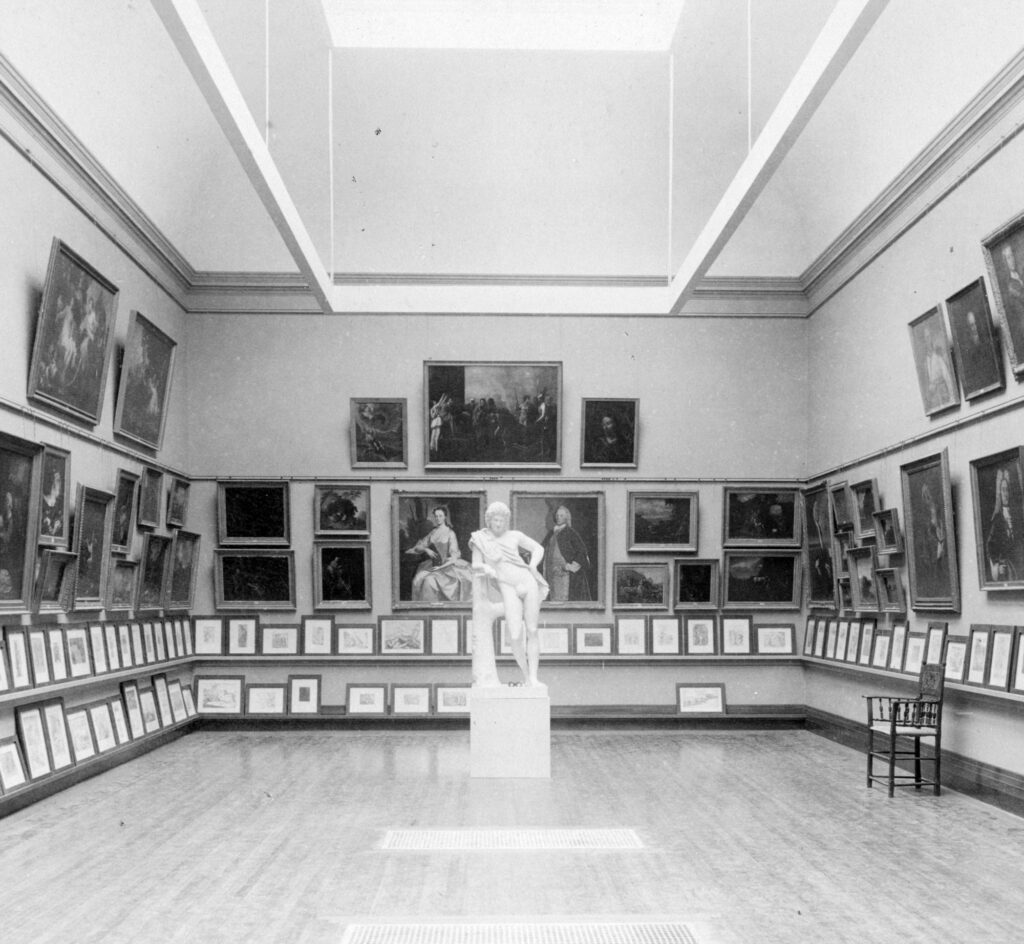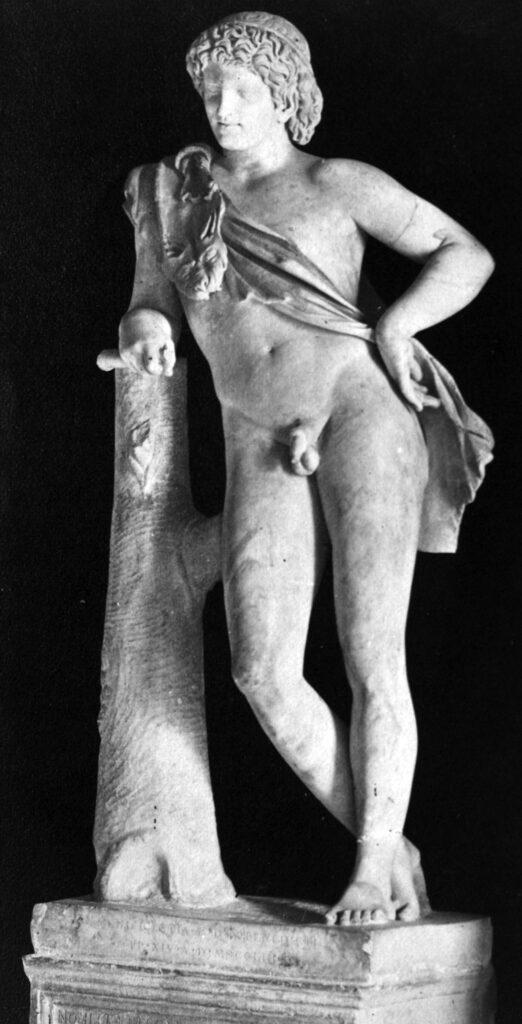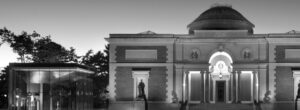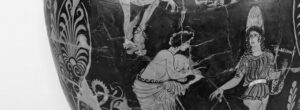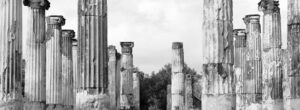While today we understand Mediterranean antiquity to be distant and remote, in the colonial period and the early years of the American Republic, Americans conceived of no such gap separating them from the heroes of the Mediterranean past. Inheriting enlightenment notions of time as cyclical, early Americans looked to the ancient world as a source, mirror, and model for right action and a just republic. American culture was steeped in echoes of the ancient Mediterranean past; however, except for a privileged few, intimacy with the ancient Mediterranean could not be traced to first-hand experience of the Mediterranean world or its art and artifacts. Until well into the nineteenth century, few Americans had the means to travel abroad, and authentic ancient art and artifacts simply did not exist in America. And yet, a “cult of antiquity” that venerated all things Greek and Roman had already taken root on American soil.

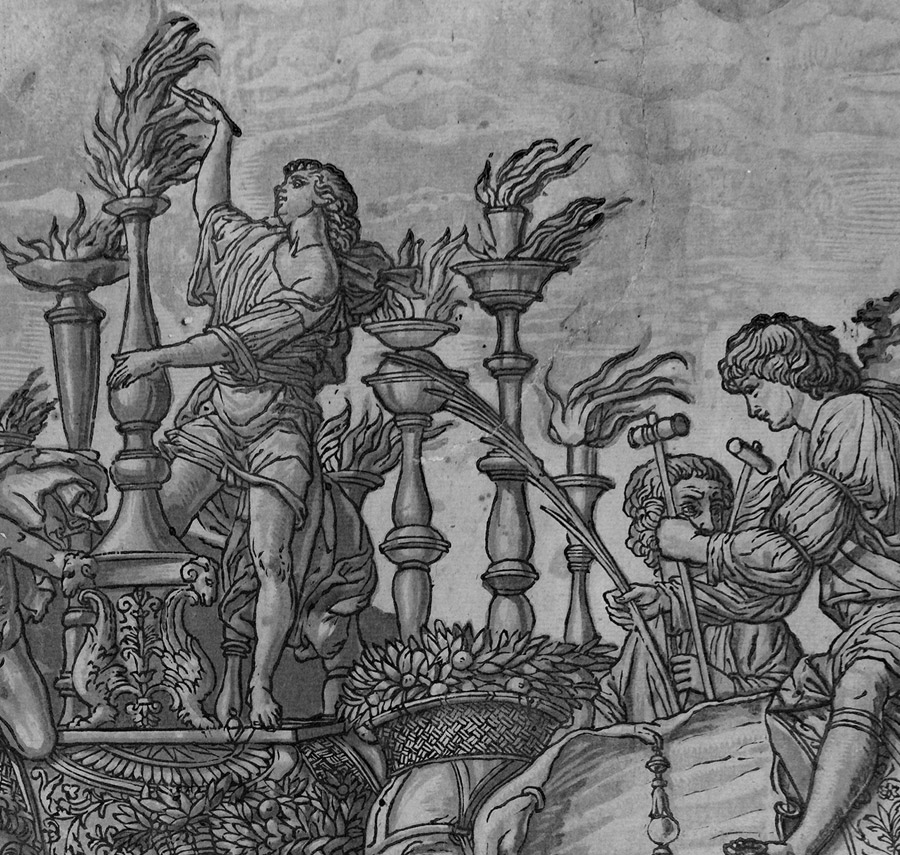
Classicism and Popular Culture in the early American Republic
The colonial and early American fascination with the cultures of the Greeks and Romans had its origins in Europe, where, for centuries, the art and literature of the ancient Mediterranean was regarded as the preeminent cultural legacy. The European Renaissance witnessed a revival of classical antiquity fueled by the rediscovery and translation of Greek and Roman texts and by excavations that uncovered ancient ruins and recovered ancient sculptures. The writings of ancient authors informed early modern debates over philosophy, politics, and history, while European arts—from painting and sculpture to literature and poetry—were transformed by exposure to ancient artifacts.
During the Renaissance, artists took their cues from the ancient world, drawing liberally on surviving myths and histories and copying ancient sculptures. Royalty and merchant princes like the Medici amassed collections of ancient art, while architects like Palladio (1508–1580) turned to ancient ruins for instruction and inspiration as they sought to recreate the glory and grandeur of the ancient world in soaring basilicas and wealthy villas. The ancient world pervaded European popular culture as well, providing inspiration for new forms of festivals and fashions, an influence captured in the woodcut of Mantegna’s (1431–1506) Triumph of Caesar in the BCMA collections. The antiquarian culture that took root during the Renaissance continued to exert a profound influence in Europe for centuries, inspiring the subject and style of artists of the Mannerist and Baroque periods.

Andrea Andreani, The Triumphs of Caesar–The Elephants (after Andrea Mantegna), ca. 1598, chiaroscuro woodcut. Bowdoin College Museum of Art, Museum Purchase, 1965.47.
View object recordIn the eighteenth and early nineteenth century, developments in archaeology and art historical scholarship brought renewed energy to the European engagement with the ancient Mediterranean that culminated in the cultural movement called neoclassicism. Excavations at Pompeii, Herculaneum, and in and around Rome recovered artifacts that provided new knowledge of art and architecture of the Roman past. Between 1801 and 1812, Thomas Bruce, Lord of Elgin, removed the Classical friezes and statuary from the Athenian Parthenon credited to the famous fifth-century BCE Greek sculptor Phidias and subsequently sold them to the British government. Their installation at the British Museum was a major event and inspired a way of classicizing fashions. Similarly, Napoleon’s conquest of North Africa and subsequent plundering of ancient Egyptian archaeological sites captivated the public imagination—and influenced art and architecture—on both sides of the Atlantic. Large contingents of scientists and scholars had accompanied Napoleon’s campaigns in North Africa, studying the cultures, languages, and histories of the region and excavating many ancient Egyptian sites; their discoveries, which included the Rosetta stone, were published in lavishly illustrated volumes.
The synthesis of such discoveries emerged in the academic discipline of art history. German scholar Johann Joachim Winckelmann (1717–1768) is often credited both with the founding of the discipline and the movement of neoclassicism. Winckelmann produced a series of landmark art history studies that firmly placed ancient art at the pinnacle of human achievements. One of Winckelmann’s lasting contributions was his hierarchy of media, which placed sculpture above painting (especially ideal sculpture and history painting) and named Classical Athens the height of all ancient achievement in the arts. Winkelmann’s ideas would also shape the way that museums have collected and displayed art, both ancient and modern, in complex ways. Writing in 1755, Winckelmann argued, “There is but one way for the moderns to become great, and perhaps unequalled […] by imitating the ancients.”
Based on the writings of Winkelmann and subsequent scholars, neoclassical artists imagined a return to the golden age of ancient art, which remained a vital source of inspiration and narrative material as it had for artists since the Renaissance. Particularly in Greek models, artists also found a refined and simple style worthy of emulation. Ancient art emphasized symmetry and harmony over embellishment, in contrast to the prevailing ornate and ostentatious rococo style of seventeenth century. In France, neoclassicism was developed in the work of artists like Jacques-Louis David (1748–1825) and predominated in the academies like the École des Beaux-Arts. In England, John Flaxman (1755–1826), a leading figure of British neoclassicism, found inspiration for his drawings in the simplified drawings of Greek vases. To illustrate the ancient epics, Flaxman created a new style based on the techniques of ancient Greek vase painters, relying heavily on outlines to create silhouetted figures and dramatically simplified settings. Flaxman’s prints, first published in 1793, were wildly popular and reprinted in several editions, often to illustrate translations of the epics.

John Flaxman, Hector Chiding Paris, 1792–1793, pen and grey ink, brush and black ink over graphite. Bowdoin College Museum of Art, Museum Purchase, Classical Fund, 1918.1.
View object recordThe popularity of Flaxman’s illustrations coincided with an increasing desire for Greek vases as Grand Tour souvenirs. From the late seventeenth to early nineteenth centuries, the Grand Tour—a tour of the cultural centers of Continental Europe—marked a rite of passage for English male aristocrats marking the completion of their education and passage into society. While the itinerary varied and often included significant stays in Paris and the resorts of the Swiss Alps, travelers most often spent a preponderance of time exploring the Italian peninsula with significant attention to its ancient ruins. These travels provided the primary means through which the art market and the subsidiary antiquarian market thrived. Grand Tourists were eager both to demonstrate their sophistication and cultivation of the arts and to acquire furnishings and decorations for their homes. A lively trade in antiquities formed, with many English tourists accumulating small collections of antiquities, chiefly vases and sculptures, to decorate their manor homes. The Grand Tour occasioned the removal of antiquities on a massive scale, by some estimates the greatest single looting of ancient art and artifacts since the sac of Greece by the Romans.
Classicism in early America echoed but also transformed Europe’s interest in antiquity, shaping it to the unique American environment. Unlike in Europe, Americans could not experience first-hand relics and ruins of the ancient Mediterranean civilizations. The few Americans who made a transatlantic voyage during this period experienced Europe more often as part of pragmatic travels , whether for professional training, business, or diplomatic missions. From the late eighteenth century into the first decades of the nineteenth, American travelers to Europe represented a trickle, fewer than two thousand annually. Thus, American encounters with antiquity were largely secondhand and can be traced to the cradle of the American curriculum, reproductions in print and plaster, and receptions of the ancient world in popular culture and the arts.
As in Europe, for centuries Americans looked upon an education in classical languages and literature as foundational. This training was seen as essential background for myriad professions, from politics to preaching. The American education system of the eighteenth and nineteenth centuries was founded on “classically saturated curricula” that sought “in the remote past new guides for modern life,” and encouraged students to look “to the Greeks and Romans to make sense of the present.” American colleges formed “cradles of classicism,” from which ancient Mediterranean culture, and particularly the literature of Greek and Roman authors, diffused into American popular print culture, jurisprudence, politics, and architecture. From this fundamental role in the education of young Americans (at least American males of a certain class) the ancient world was positioned “front and center in American political and intellectual life.” Plays such as English playwright Joseph Addison’s (1672–1719) Cato were standard fair in American theaters. A burgeoning import and domestic print culture satisfied much of the American curiosity in the ancient Mediterranean world, and images inspired by antiquity featured prominently in American newspapers and broadsides of the period.
During this period, the desire to consume and collect antiquity was mostly achieved through the collection of prints and books that portrayed ancient monuments and ruin, together with the occasional painting with ancient themes or plaster or marble copy of ancient masterworks. Scholarly works were imported from overseas and provided the means for Americans to cultivate knowledge of ancient and Renaissance principles like those of Vitruvius and Palladio respectively. At the same time, prints reproducing views of ancient architecture and artifacts then being excavated in Europe were, for the first time, available on both sides of the Atlantic.
The work of Italian engraver Giovanni Battista Piranesi (1720–1778) is a prime example of this eighteenth-century development. The antiquarian and master printmaker can be credited with creating some of the most iconic and widely circulated images of the Italian peninsula and its ancient ruins. Trained as an architect and draftsman, Piranesi applied these skills to produce studies of Roman ruins that were popular sites among tourists. His most famous series, the Vedute di Roma (Views of Rome, 1750–1778), occupied the better part of the artist’s energies for three decades and included views of the Colosseum, the Arch of Titus, the Pantheon, and other monuments throughout the city.

Giovanni Battista Piranesi, Interior of the Coliseum, 1720–1778, etching and drypoint. Bowdoin College Museum of Art, Gift of Charles A. Coffin, Honorary Degree 1922, 1923.105.
View object recordThe hundreds of inventive and intricately detailed views he created during his lifetime, especially of Rome, were extremely popular souvenirs among eighteenth-century English gentry on the Grand Tour. His prints had already made their way to America by the 1760s and were owned by leading figures with antiquarian tastes like Thomas Jefferson, who owned a copy of Piranesi’s Antichita di Ercolano. Bound as a series in volumes or sold as individual sheets, Piranesi’s works continued to be printed well into the nineteenth century and were equally popular among American tourists of this period. By the middle of the nineteenth century, Piranesi’s etchings could be found in many public and private collections in the United States, including a complete set gifted to the Boston Public Library in 1869. As objects of study, the prints were popular until well into the nineteenth century, when the invention of photography largely supplanted the print by offering a more faithful and accurate rendering of ancient relics and ruins.
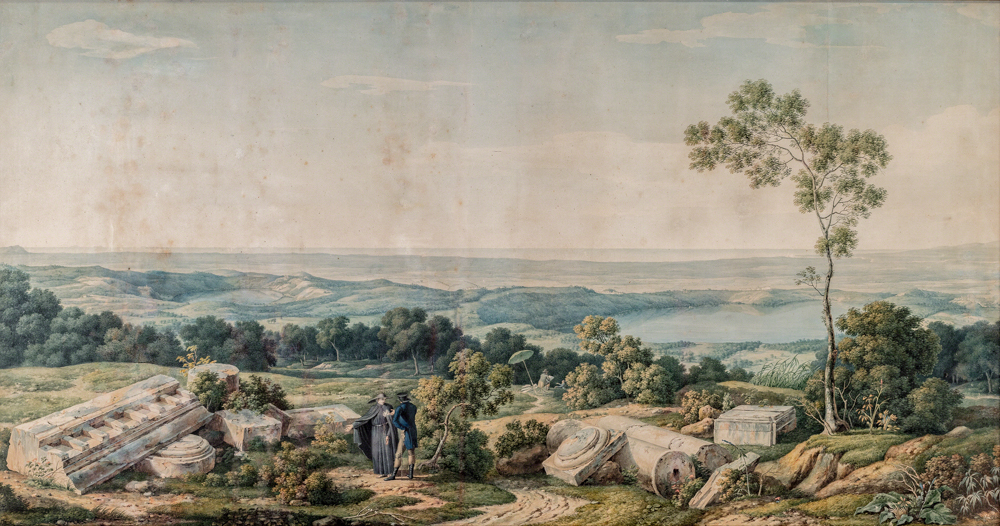
John Izard Middleton, View from the Summit of Monte Cavo. Design for Plate I of Grecian Remains in Italy., 1809, watercolor. McGuigan Collection.
View object recordThe first American treatise on archaeological sites and ancient ruins also dates to this period. John Izard Middleton’s (1785–1849) Grecian Remains in Italy (1812) was the earliest publication by an American to provide access to ancient Mediterranean ruins, proposing “to give the Public an accurate idea of objects so highly worthy of their notice.” Featuring twenty-two richly colored aquatints based on watercolors by the artist and another two plates of engravings, the lavishly illustrated volume was based on notes and sketches that Middleton made while travelling through Italy in 1808 and 1809. Middleton’s deep knowledge of ancient history and literature is apparent in the scholarly text he authored to accompany his illustrations, panoramic vistas of central Italy and close studies of archaeological ruins at sites like Alatri and Segni.
Middleton, like all wealthy American males, was well schooled in ancient literature. As members of the Southern elite, the Middleton family was well acquainted with the ancient world, and the furnishings and art displayed in their Southern home reflected the cultured and classicizing tastes appropriate of their status. During the colonial period, the young Middleton males were schooled in England, and John Izard Middleton’s father and mother made the Grand Tour between 1768 and 1771, during which they acquired artworks and books and had their portrait painted by Benjamin West (1738–1820) in London. Albeit an amateur artist without formal training, Middleton’s studies reproduced in Grecian Remains are both technically skilled and architecturally accurate, enabling American and European readers to study in detail newly uncovered ancient ruins. At the end of the nineteenth century, Charles Eliot Norton, the Harvard professor and eminent American art historian and authority on ancient art, would describe Middleton as America’s first classical archaeologist and Grecian Remains as a “cornerstone” of an emerging American field of classical archaeology.
Like prints and publications, plaster casts of antiquities played an important part in introducing Americans to ancient sculptures from the eighteenth century through the early twentieth century. The first casts to arrive in the American colonies were likely brought for educational purposes by the Scottish painter John Smibert (1688–1751). Smibert was the first academically trained artist to paint in Colonial America. After accompanying Bishop George Berkeley across the Atlantic (in a failed quest to found a new University in Bermuda), Smibert arrived in Boston in 1729 with plaster casts, including a bust of Homer, the Venus de Medici, and the Laocoön Group. These casts and the copies of major paintings that Smibert had done in Europe served as important resources for early American artists, exposing them to classicizing style and themes prominent in Europe.
Even plaster casts, however, were out of reach for many Americans both because of the costs associated with shipping them across the Atlantic and the likelihood they wouldn’t survive the overseas voyage in one piece. While a young Thomas Jefferson had plans to furnish Monticello with copies of famed ancient Greek and Roman sculptures (including, according to a list he devised: the Venus de Medici, Apollo Belvedere, and the Spinario) , he was never able to fulfill this dream. The marble copy of the Ariadne sculpture in the Vatican, gifted to Jefferson by Bowdoin College founder James Bowdoin III (1752–1811) in 1805, was as close as Jefferson came to satisfying this aspiration. Instead, collectors like Jefferson often contented themselves with collecting smaller busts of famous figures past and present. Jefferson’s collection of busts featured noted European and American contemporaries like Voltaire, Napoleon Bonaparte, Alexander Hamilton, and Benjamin Franklin, but they also included a group of four small bronzes of Roman Emperors, including Tiberius and Vespasian.
The life, travels, and collecting of James Bowdoin III are illustrative of the late eighteenth- and early nineteenth-century trend among America’s elite of embracing classicism as an expression of taste and refinement. Bowdoin figured among a small group of leading figures—among them Thomas Jefferson—who recognized the value of art in a budding republic for the fostering of enlightened ideals and philosophical contemplation. The core of the Museum’s collection was formed by Bowdoin’s 1811 bequest of what was, at the time, one of the largest collections of fine art in the country. The artworks in Bowdoin’s bequest included 141 Old Master drawings and some six dozen paintings, the gift of which formed the earliest such public collection in the United States.
James Bowdoin III’s father, James Bowdoin II, was a wealthy merchant and the second governor of Massachusetts, and both father and son were prominent proponents of the American revolution. The household that Bowdoin III grew up in was one of the wealthiest in Massachusetts. The family’s money derived from land and trading, and it is important to acknowledge that James Bowdoin II enslaved a number of domestic servants throughout his life. Not by chance, several of these enslaved individuals had names drawn from ancient myth and history, a topic of great relevance to the reception of the ancient world in America. Never aspirational, names like Venus and Hercules given to enslaved people were often laden with ironic or sexualized connotations and part of the Southern enslaver’s model of a new Rome, founded on agrarian principles and replete with Greek revival architecture, much of which was built through slave labor, as at Drayton Hall.
It was also the case that James Bowdoin II had one of the most extensive libraries in the colonies, including numerous scientific devices such as telescopes. It also featured a growing collection of art, including prints, small plaster casts, portraits of the Bowdoin family by Smibert and other respected colonial portrait artists, and nine paintings from Italy. Though the precise nature and circumstances of these works are unknown, they clearly formed a background for James Bowdoin III, who would continue to build on his father’s important cultural legacy.
Upon graduating from Harvard in 1771, Bowdoin III embarked on the first of several European travels made during his lifetime, studying at Oxford and making the Grand Tour. During this period, the heyday of the Grand Tour, few Americans could afford to participate purely as a matter of leisure and acculturation. Bowdoin III and his companion Ward Nicholas Boylston were among the few to possess both the means and the motivation to take part in the Grand Tour tradition during its peak.
Through his travels, Bowdoin was exposed to ancient ruins, archaeological sites, and European museums and collections like those of Sir William Hamilton in Naples, who had recently independently published and then sold his collection of hundreds of Greek vases and Bronzes to the British Museum. Boylston’s diary of their travels confirms the sense of awe and wonder the pair felt being exposed to such grand European collections and ancient Mediterranean sites like Vesuvius. The antiquarian inspiration Bowdoin encountered in Europe, as well as the works of art he acquired during his Grand Tour and later European travels, formed the genesis of what is today the Bowdoin College Museum of Art.
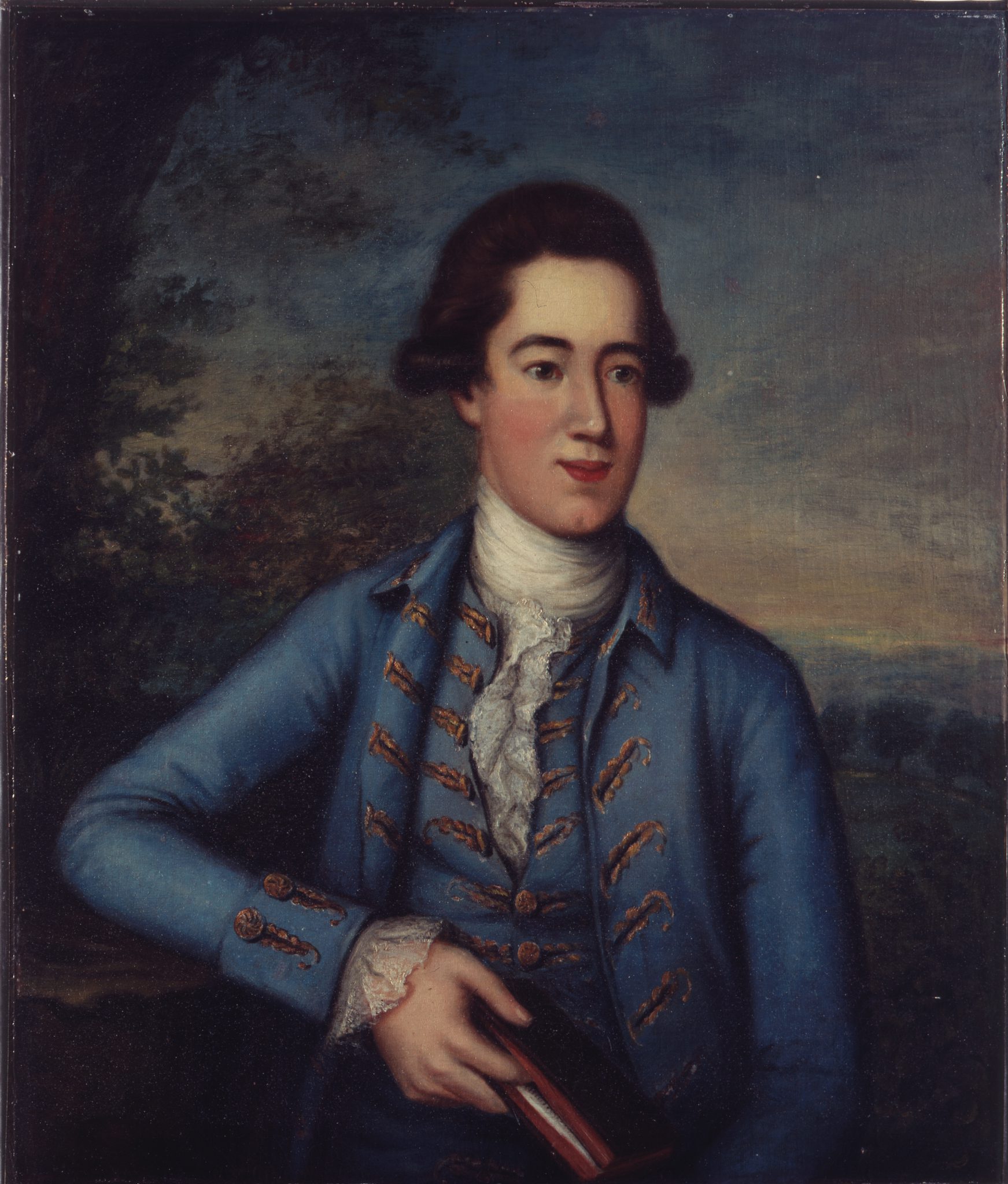
Unknown Artist, Portrait of James Bowdoin III, ca. 1771-1775, oil on canvas. Bowdoin College Museum of Art, Bequest of Mrs. Sarah Bowdoin Dearborn, 1826.1.
View object recordThe young Bowdoin’s means were decidedly more modest than relative to those of the English gentry with whom he dined and visited during his Grand Tour, and there is no record that he acquired antiquities, these probably being prohibitively expensive to acquire and ship across the Atlantic. But, having developed a keen interest in collecting and a passion for the past, Bowdoin found other ways to satisfy the acquisitive urge throughout the remainder of his life. For example, Bowdoin had his portrait painted during his travels, a venerable tradition for travelers on the Grand Tour: a way of documenting a transformative experience and indicating the cultural sophistication acquired by the traveler. The painting shows the young Bowdoin against an Italianate landscape with a book in hand and wearing elegant clothing. The latter suggests a taste for finery cultivated by many Americans who traveled to Europe during this period, but which would have been out of place in colonial America.
The commission of this painting was connected to other acquisitions, and Bowdoin’s letters indicate that he sent home several crates of artworks. While the precise nature of his acquisitions remains unknown, they represent the beginnings of what was to be a sustained project of collecting original art, then a rarity even among the America’s patrician class. While this pursuit no doubt originated in his early European travels, Bowdoin continued collecting throughout his life, including during a later diplomatic mission to Spain, and in America, buying, for example, from the estate of Boston-based John Smibert.
Like other wealthy Americans of his generation, Bowdoin’s passion for antiquity originated in his encounters with antiquity in books. As he began to amass a large library of his own, his holdings would include many works by ancient authors. They also included scholarly volumes on ancient art and architecture by Johann Joachim Winckelmann, by the French archaeologist Alexandre Lenoir (1761–1839), and by Scottish classicist Alexander Adam (1741–1809). Bowdoin’s bequest to the College in 1811 included over two thousand volumes.
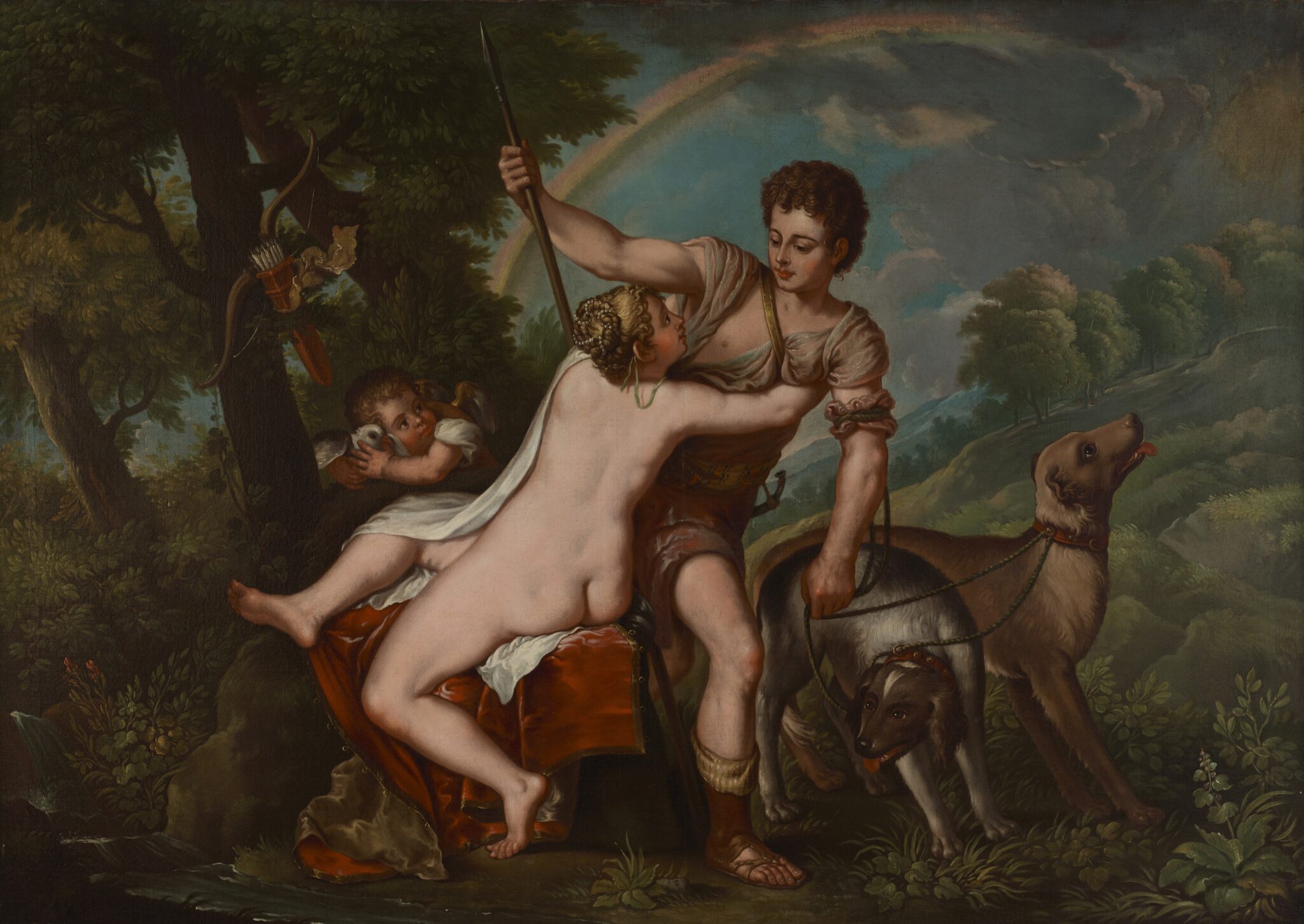
Unknown Artist after Titian, Venus and Adonis, after 1804, oil on canvas. Bowdoin College Museum of Art, Bequest of the Honorable James Bowdoin III, 1813.21.
The paintings that Bowdoin collected during his life include both original oil paintings by American and European artists as well as copies after well-known works. They exhibit a diversity of interest but with a particular taste for grand history painting featuring narrative scenes of biblical and classical myth and legend, such as a large copy of Titian’s Venus and Adonis. Bowdoin’s dedication to building a collection is evident in the diverse subjects and types of drawings and paintings he bequeathed to Bowdoin, which include religious themes and classical myth, historical subjects, portraits, landscapes, and figure studies. For all its diversity, certain patterns of collecting emerge that illuminate the tastes of Bowdoin and, by extension, early American consumers of Mediterranean history and culture. The paintings and drawings that Bowdoin collected over a lifetime of European travel demonstrate how the culture and heritage of the Mediterranean world—chiefly of Greek and Roman antiquity but also of the Biblical and Mesopotamian worlds—were made global in the act of making them the proper inheritance of America(ns).
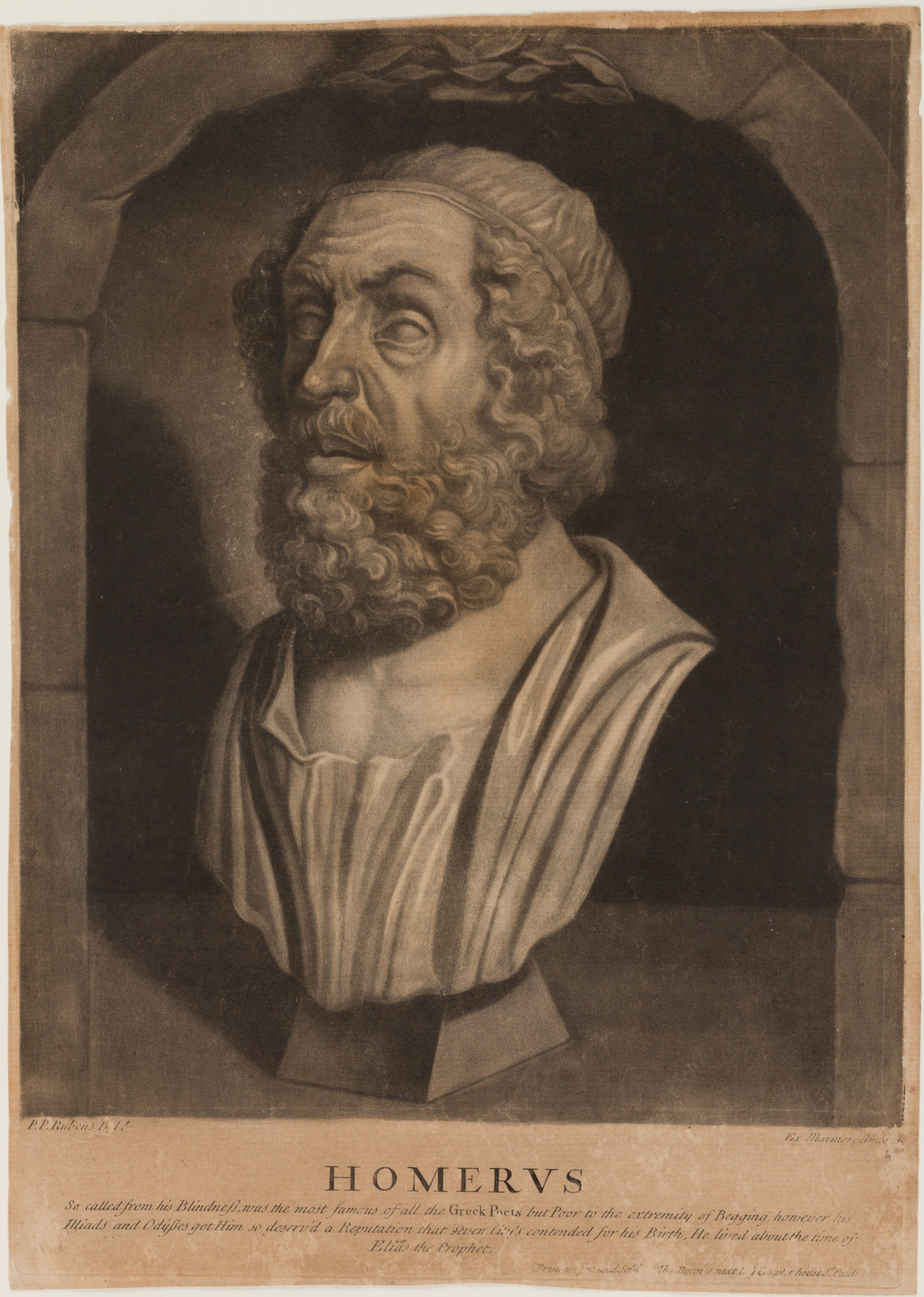
Johan Faber the Elder, Homer, 1710, mezzotints. Bowdoin College Museum of Art, Bequest of the Honorable James Bowdoin III, 1813.58.
View object recordBut Bowdoin also collected other works, particularly drawings and prints that could be consulted as resources for imagining the ancient world, meditating on the morals of history, and illustrating his own lifelong studies. Among these were a series of prints by Johan Faber the Elder (1660–1721) depicting notable poets, philosophers, and orators from antiquity. Collecting busts of famous figures past and present was in fashion in the eighteenth century on both sides of the Atlantic. Comporting with this fashion like his contemporary Jefferson, Bowdoin III, probably acquired the prints during his time in London and considered them exemplars of ancient achievement.
Artists were among the first intrepid Americans to venture abroad to study the remains of ancient Mediterranean cultures. Celebrated early American painters all travelled to Europe to acquire their training. Beginning in the eighteenth century and throughout much of the nineteenth, European travel came to be seen as a rite of passage for American artists. Their itineraries included exploring ruins and recently excavated archaeological wonders like Pompeii, and, in the tradition of generations of artists before them, studying and sketching in the sculpture holes of grand European collections like those of the Vatican and the Capitoline museums. Through their training and travels, the antiquarian culture and prevailing neoclassical style of Europe had a profound impact on American arts and culture. Images of the ancient world abound in American art of the nineteenth century, when American artists and patrons creatively used antiquity in everything from prints to portraiture to porcelain.

Benjamin West, The Capitoline Antinous, ca. 1760–1763, black chalk and white heightening on blue laid paper. McGuigan Collection
View object recordAs the first American-born artist to cross the Atlantic and study in Europe and a renowned painter of historical scenes, Benjamin West (1738–1820) occupies an important place in the history of American art. Sponsored by a wealthy Philadelphian, West travelled to Italy in 1760 to undertake the Grand Tour. Like generations of artists before and after him, West studied masterworks of ancient sculpture in Rome to learn principles of the human figure, thought to have been perfected by the ancient Greeks. During his time in Italy, West was also introduced to some of the most prominent figures in the neoclassical movement sweeping Europe at the time, including fellow artists Anton Raphael Mengs (1728–1779) and Anjelica Kauffman (1741-1807) and antiquities collector Cardinal Alessandro Albani. Though he maintained close ties to the United States and remained popular among American patrons, West never returned to America. Instead, he settled in London where he became a painter to the court of King George III and a key figure in launching the Royal Academy of Arts.
West devoted his energies to grand historical paintings depicting important moments of both contemporary and ancient history. His early studies in Italy shaped his art throughout his career, and the principles and poses he learned from classical statuary—as well as his deep appreciation of ancient myth and history—can be detected in many of his later paintings. West’s London studio was a popular destination for American travelers, and he trained a veritable who’s who of early American painters including John Vanderlyn (1775–1852), Washington Allston (1779–1843), Thomas Cole (1801–1848), John Gadsby Chapman (1808–1889), and Rembrandt Peale (1778–1860).
For artists like West, Europe offered experiences, education, and freedoms not available in America from the ability to draw from live, nude models to access to galleries of art and assemblages of casts. The presence of fine arts academies enabled artists to receive formal training and mentorship from established European painters and sculptors, at a time when America had none. Where Europe exerted a profound pull for American artists, America equally pushed sculptors and painters to leave the country. Americans had little appreciation for the fine arts. The American art market was in its infancy, and there were no major museums and few institutions devoted to the cultivation of the arts. Until well into the nineteenth century, most artists sold directly to clients out of their studios, and portraiture predominated.
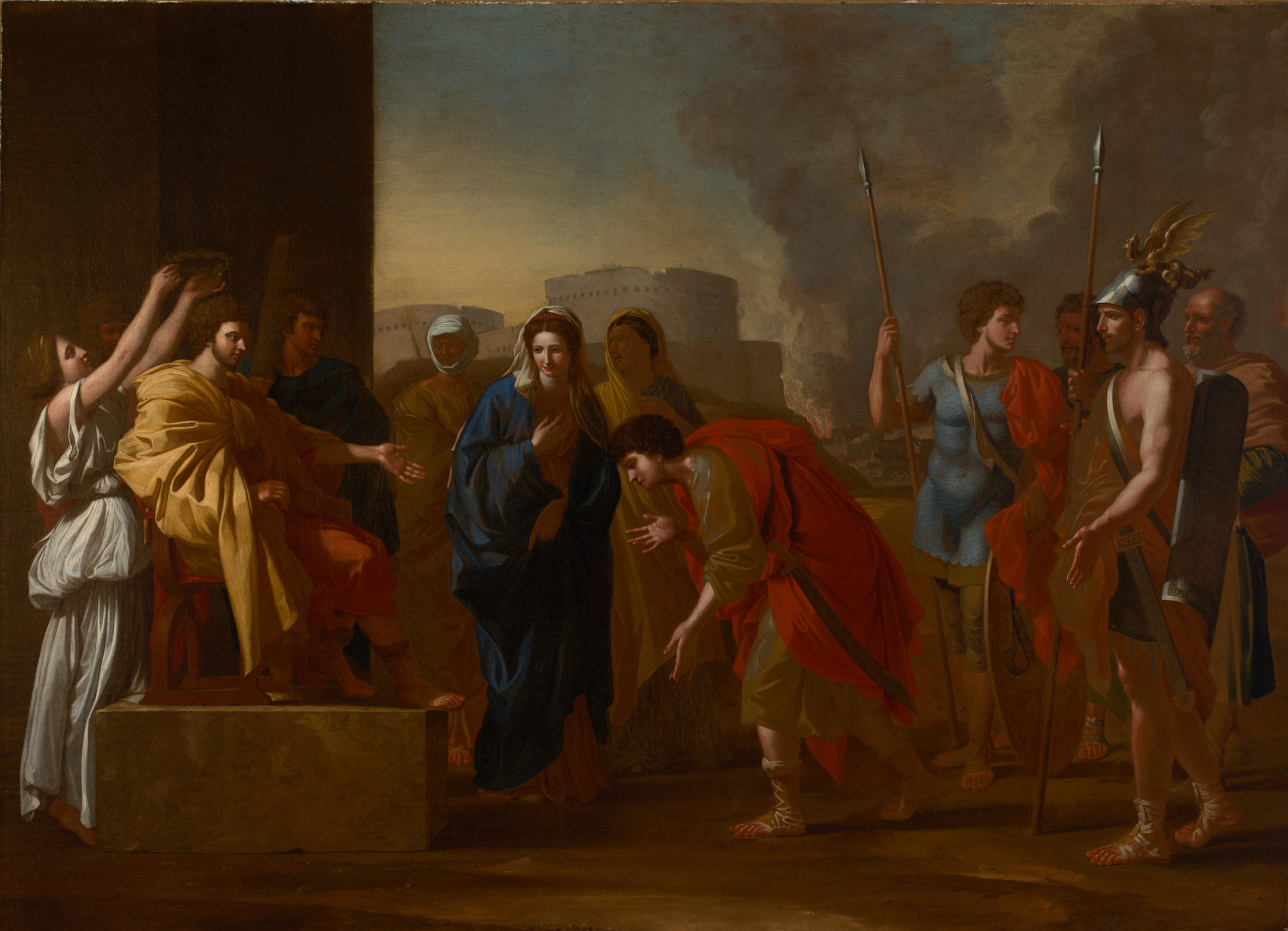
John Smibert, The Continence of Scipio, ca. 1726, oil on canvas. Bowdoin College Museum of Art, Bequest of the Honorable James Bowdoin III, 1813.10.
View object recordAmerican artists like West looked to European models of classicism for aesthetic and moral instruction. John Smibert’s The Continence of Scipio—a close copy after a painting made in 1640 by Nicholas Poussin (1594–1665)—tells the story of the Roman general Scipio Africanus, who, having just captured the city of Carthage, surveys the spoils of war. The moment of decision and high drama captured in this history painting is Scipio’s decision to return the beautiful female captive to her fiancé, a Carthaginian prince, rather than taking her for himself. The story, long popular in Europe, took on new meaning in America, where Scipio’s self-control provided an exemplum virtutis (an example of virtue) but also a parable of victory and conquest that held profound meaning for Americans after the Revolution. Bowdoin bought this copy as well as several drawings from Smibert’s Boston studio, which together formed part of his 1811 bequest. In addition to cultivating aesthetic appreciation, it is likely that this painting was used to instruct students academically and morally in the early years of the College.
The classicism embodied in paintings like Smibert’s copy of The Continence of Scipio ran up against deep currents of ambivalence in America, a country that revered moral simplicity and pragmatism and where the fine arts might be considered simultaneously immoral and impractical. Yet, while many Americans criticized the decadence of Europe in favor of an austere, agrarian ideal, Americans like James Bowdoin III and Thomas Jefferson were among a small group of early American figures who perceived the important role that culture could play in shaping a burgeoning country. In these circles, the turn to antiquity was often couched in ways that provided a veneer of moral instruction for artists and patrons alike. In the ancient world were to be found ideal beauty, moral allegory, and instruction. The fine arts were defended in America as both moral and educational, a bulwark against barbarism. More pragmatically, it was argued that the arts were a better and more moral outlet for the growing wealth of Americans than other leisure pastimes of the period, like gambling and racing, because the arts provided repose for the soul and elevated the character and judgement of the nation.
Like Bowdoin III, Jefferson was also deeply interested in the development of the fine arts in the United States. While travelling in England, Jefferson befriended the American artist John Trumbull (1756–1843), inviting him to stay with his family in Paris and supporting Trumbull’s monumental history painting The Declaration of Independence, a version of which was later commissioned for the US Capitol Rotunda. In Paris, Jefferson also befriended leading neoclassical artists including Charles Louis Clérisseau (1722–1820), painter Jacques-Louis David (1748–1825), and French neoclassical sculptor Jean-Antoine Houdon (1741–1828). On numerous occasions Jefferson tried to forge transatlantic connections between the neoclassicism he encountered in France and the emerging American arts, including commissioning Clérisseau for the classically inspired design of the Virginia State Capitol.

Jean-Antoine Houdon, George Washington, ca. early 18th c. CE, bronze. Portland Museum of Art, Anonymous Gift, 0000.2022.5.
View object recordJefferson’s commissions illustrate the degree to which American classicism was inspired by contemporary European culture. In 1784, the Virginia General Assembly voted in favor of commissioning a statue of General George Washington for the Virginia State House. The resolution dictated a sculpture “of the finest marble and the best workmanship,” and was understood to require the work of a European sculptor. Jefferson, then minister to France, chose Houdon, who was widely recognized as Europe’s leading sculptor. Writing to Governor Harrison of Virginia in 1785, Jefferson indicated that “[t]here could be no question raised as to the Sculptor who should be employed; the reputation of Monday. Houdon, of this city [Paris], being unrivalled in Europe.”
Houdon took up the commission with gusto and travelled to America in 1788 to take Washington’s likeness. The bust Houdon modeled at Mount Vernon and life-mask he created are among the most accurate depictions of Washington made during his lifetime and provided models for generations of later artists including Horatio Greenough (1805–1852), who procured a copy of the bust to complete his own commission of 1832. This bronze bust is based on a terracotta original modeled at Mount Vernon and now in the Louvre.
During Houdon’s execution of the original, which was not completed until 1790 or 1791, considerable debate over how to depict the famous general involved Jefferson, Houdon, Benjamin Franklin, Benjamin West, and, eventually, Washington himself. Houdon evidently conceived of the statue as showing Washington in classical guise, either as a Roman general or farmer, in keeping with his reputation as the American Cincinnatus after the victorious Roman general who returned to his farm instead of taking up the reins of power in the fifth century BCE. In 1786, Washington wrote to Jefferson that, while no expert in sculpture, “perhaps a servile adherence to the garb of antiquity might not be altogether so expedient as some little deviation in favor of modern costume.” Though his intervention settled the matter in favor of contemporary clothing that alluded to his military service, subtle (and overt) references to antiquity were worked into the pose and accoutrements of the final statue.
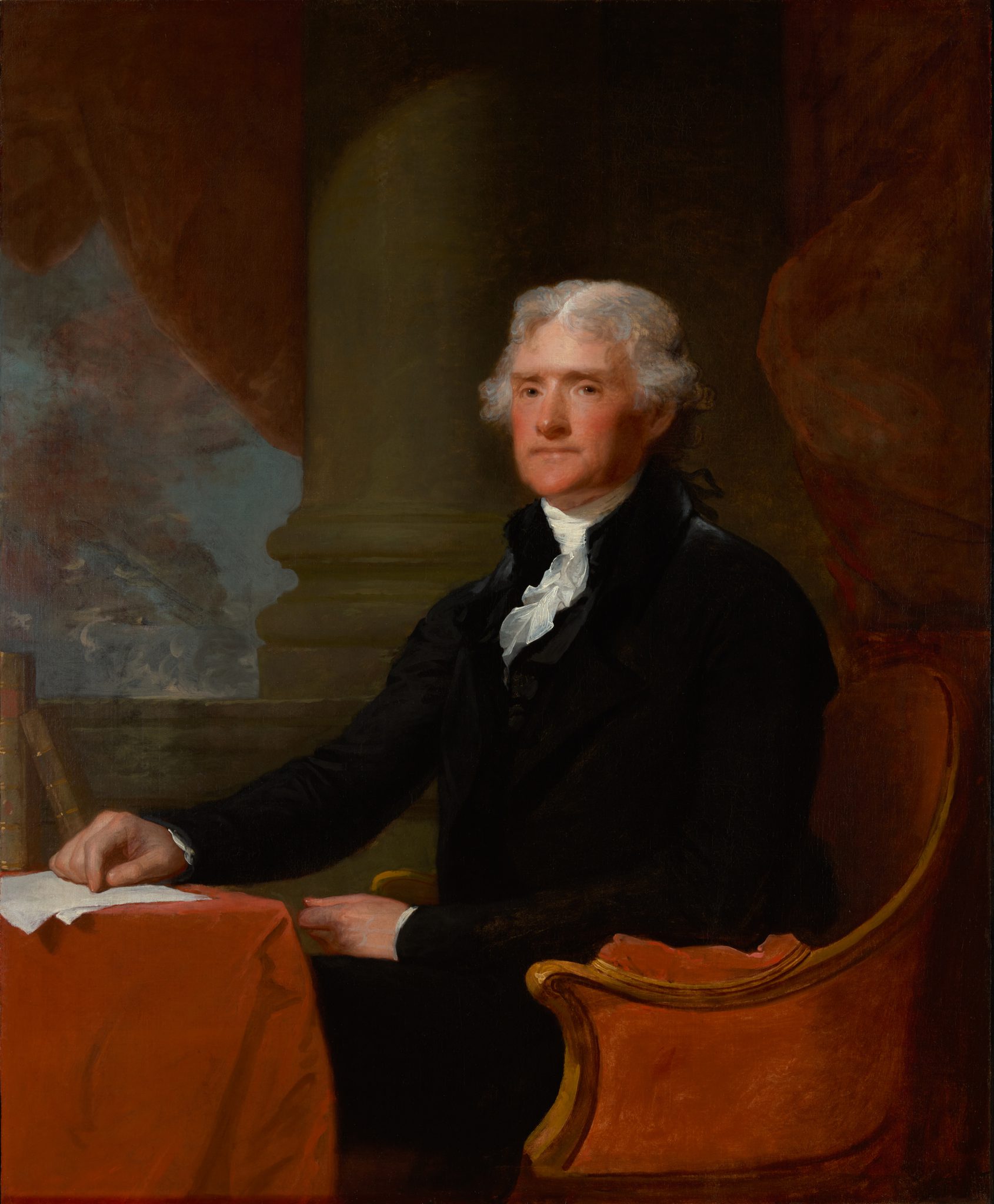
Gilbert Stuart, Portrait of Thomas Jefferson, ca. 1805–1807, oil on canvas. Bowdoin College Museum of Art, Bequest of the Honorable James Bowdoin III, 1813.55.
View object recordSimilar references appeared in a portrait of Jefferson by the American portraitist Gilbert Stuart (1755–1828). Jefferson is shown against a classical backdrop with ionic columns framing the composition. These architectural details allude to the classical foundations of the American project: the democratic ideals and republican political system that Jefferson and his peers derived largely from knowledge of Greek and Roman history. While the classical references in this painting are subtle, they are part of a trend in American portraiture of the nineteenth century to depict prominent Americans in classicizing modes.

Nathaniel Smibert, Portrait of Reverend Samson Occom, ca. 1751–1756, oil on canvas. Bowdoin College Museum of Art, Bequest of the Honorable James Bowdoin III, 1813.4.
View object recordThe appeal to antiquity was not exclusive to wealthy white males, as illustrated in The Portrait of Reverend Samson Occom by Nathaniel Smibert, collected by James Bowdoin III. The painting depicts the prominent minister of the Connecticut Mohegan tribe who graduated from Dartmouth founder Eleazar Wheelock’s “Latin School.” In contrast to other contemporary depictions of Occom, which obscure his Native American ethnicity, Smibert’s painting of the Reverend combines clear indications of Occom’s indigeneity with the dress of a Roman senator, a blending of cultural references that would have been both legible and curious to contemporary viewers. The Roman garb is undoubtedly a reference to Occom’s classical learning and oratorical skills, founded on his mastery of Greek, Latin, and Hebrew. The portrait bears witness to the belief in the universality of classical learning and the pervasiveness of Mediterranean antiquity in early America, even as it today raises important questions about colonial legacies and the erasure of indigenous history, culture, and ways of learning.
The poems of Philliss Wheatley (1753–1784), an enslaved author and poet whose story, similarly illustrates the creative ways the ancient world was employed by early Americans, regardless of race, class, or gender. Wheatley was schooled beside her enslavers’ children in a variety of subjects, including Greek and Latin literature, and by age eighteen she had composed enough poems to publish an anthology. But her efforts to find an American publisher were for naught. Instead, in 1773, she published her collection in London under the title Poems on Various Subjects, Religious and Moral. So incredulous were white Americans that an enslaved woman could author such poetry, the publication was accompanied by a statement attesting that the author had been examined and verified by a board of prominent Bostonians, including James Bowdoin II.

Frontispiece to Poems on Various Subjects Religious and Moral by Phillis Wheatley, 1773. Collection of the Smithsonian National Museum of African American History and Culture, 2012.46.46.
It is also essential to note the vital role that many enslaved Black American’s played in creating art and architecture inspired by the ancient world. Jefferson’s architectural forays—whether at the Virginia State Capitol, his plantation home Monticello, or the University of Virginia campus he designed—were ultimately executed by a combination of paid laborers and unpaid enslaved persons, including many skilled artisans and craftsmen. Over the course of his life, Jefferson enslaved over six hundred people beginning when he was given an enslaved individual named Jupiter as a personal servant when he was a teenager. Though Jefferson consistently described slavery as abhorrent and expressed concern that it could wreck the fledgling American project, he continued to profit from and prop up the institution and is known to have granted freedom to only six individuals in his lifetime.
One of those individuals was John Hemmings, who became a master carpenter and woodworker who created classically-inspired furniture and architectural elements for Jefferson’s homes and was one of the few enslaved peoples freed in Jefferson’s will in 1826. Similar stories of enslaved Black labor intimately engaged in the production of neoclassical architecture and decorative arts played out across the nation, from the Capital in Washington DC, to places like Drayton Hall in South Carolina.
Meyer Reinhold, Classica Americana : The Greek and Roman Heritage in the United States (Detroit: Wayne State University Press, 1984).
Johann Joachim Winckelmann, Reflections on the Painting and Sculpture of the Greeks: With Instructions for the Connoisseur, and an Essay on Grace in Works of Art, English edition ed. (London, 1765).
{Dyson, 2006 #911@7 TK}
Daniel Kilbride, Being American in Europe, 1750-1860 (Baltimore: Johns Hopkins University, 2013).
Caroline Winterer, The Culture of Classicism : Ancient Greece and Rome in American Intellectual Life, 1780-1910 (Baltimore; London: The Johns Hopkins University Press, 2004), 41.
Winterer, The Culture of Classicism : Ancient Greece and Rome in American Intellectual Life, 1780-1910, 1–16.
Winterer, The Culture of Classicism : Ancient Greece and Rome in American Intellectual Life, 1780–1910.
Thomas E. Ricks, First Principles: What America's Founders Learned from the Greeks and Romans and How That Shaped Our Country (HarperCollins Canada, Limited, 2020), xxiv.
Winterer, The Culture of Classicism : Ancient Greece and Rome in American Intellectual Life, 1780-1910, 29.
Wendy Cooper, "Classical Taste in America, 1800-1840," ed. Baltimore Museum of Art (New York: Abbeville Press, 1993), 79.
{Dickson, 1976 #912@125 TK}
On Bowdoin’s Grand Tour and its influence on his development as a collector, see further Richard H. Saunders III, "James Bowdoin III (1752 - 1811)," in The Legacy of James Bowdoin III, (Brunswick, ME: Bowdoin College Museum of Art,1994).
See The Legacy of James Bowdoin III, (Brunswick, ME: Bowdoin College Museum of Art,1994).
For a discussion of the adaptation of the legend of Scipio in the American landscape and examples of the Continence in American visual culture, see Caroline Winterer, "From Royal to Republican: The Classical Image in Early America," The Journal of American History 91, no. 4 (2005). link
See further Margaret Malamud, African Americans and the Classics Antiquity, Abolition and Activism (2019), 13–16.
